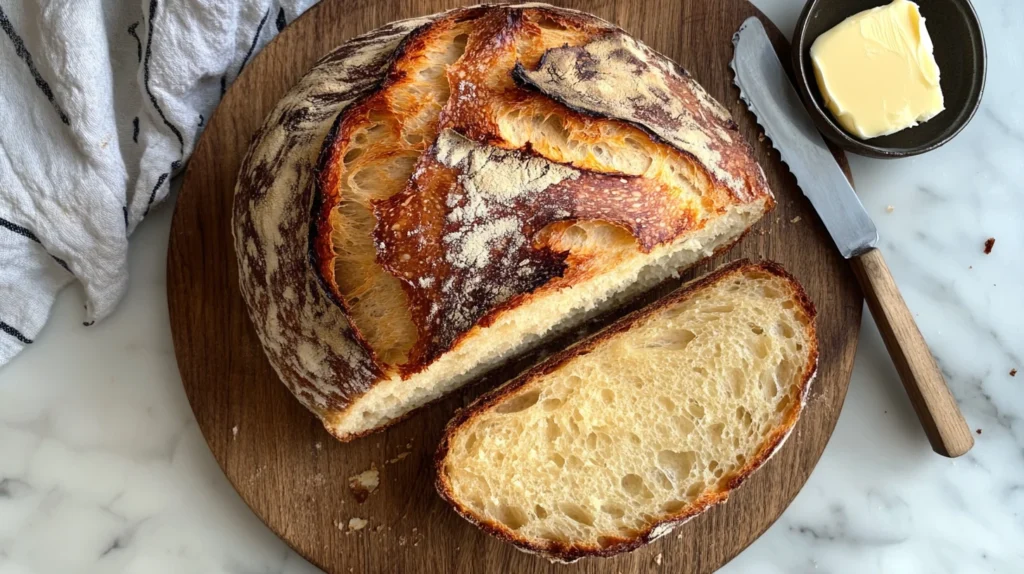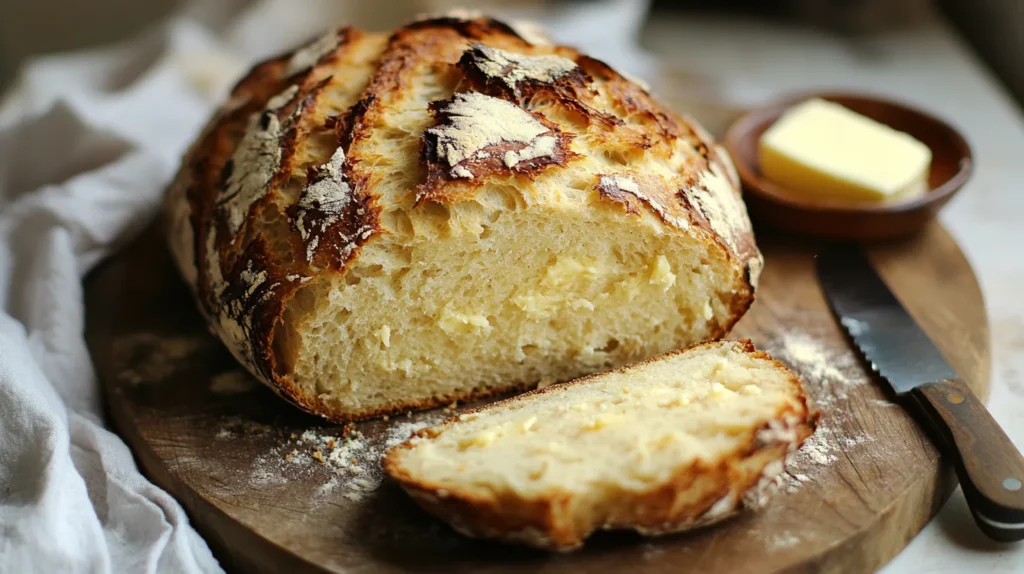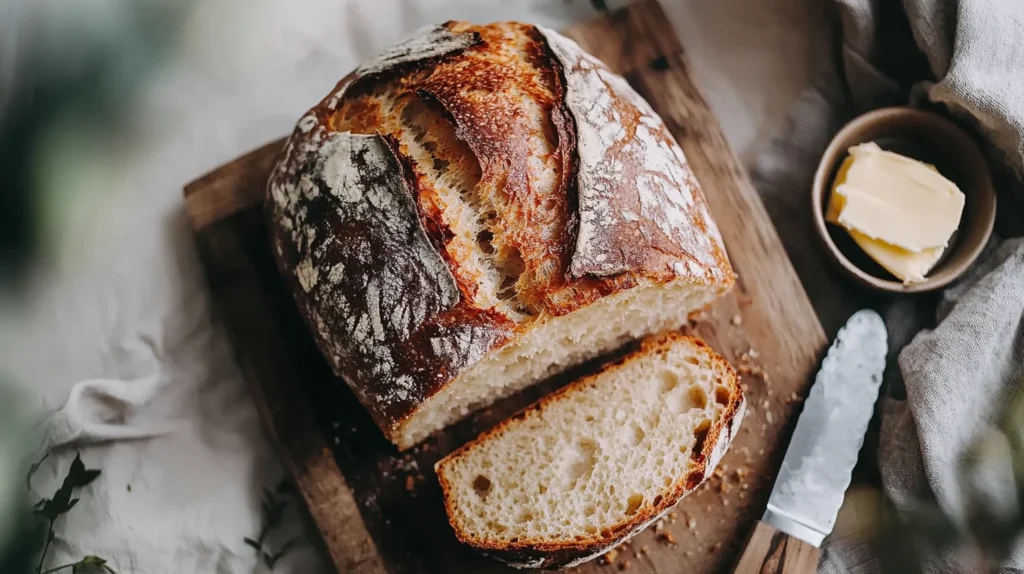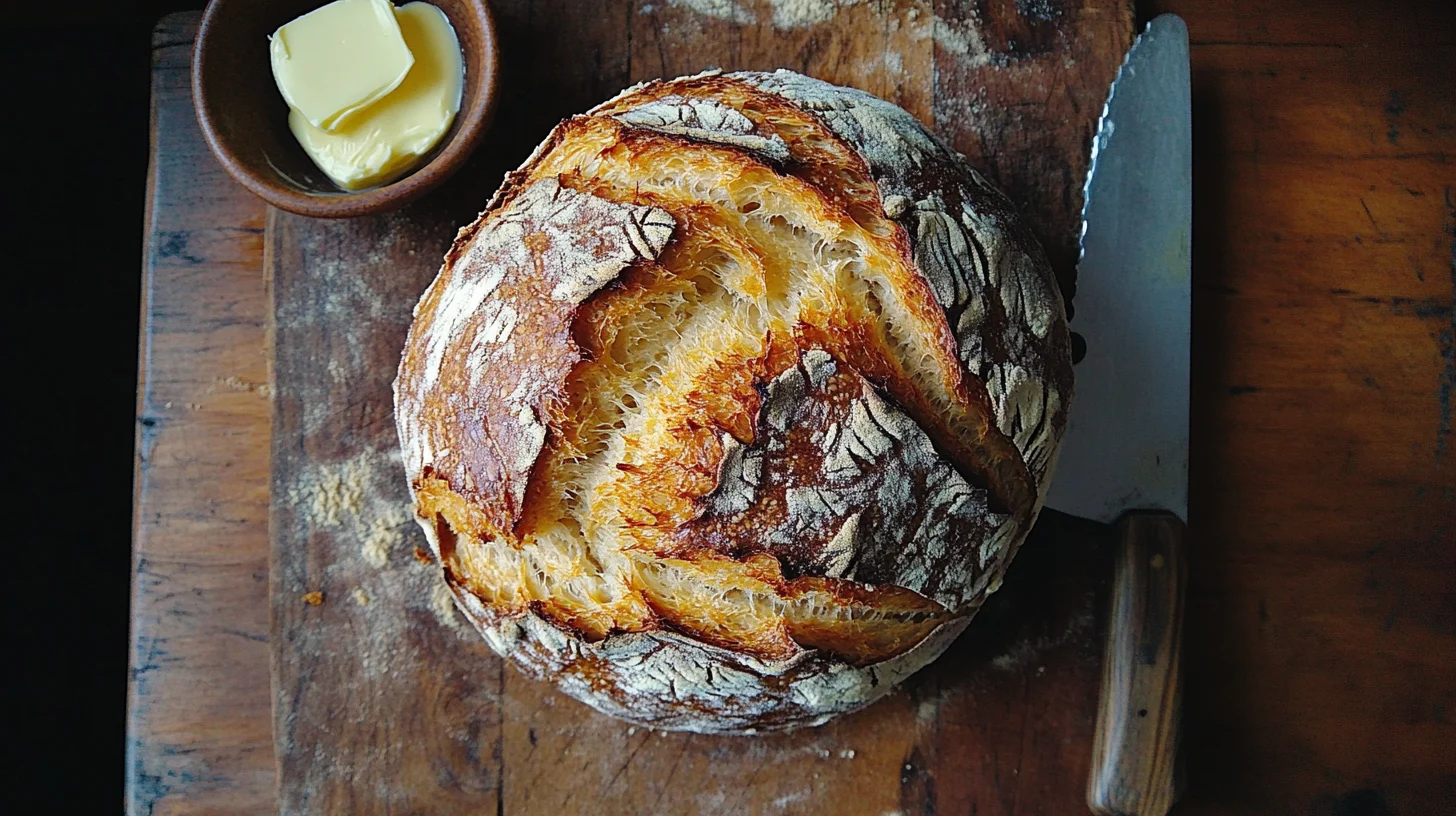Gluten-Free Sourdough Bread is more than just an alternative for those who can’t consume gluten; it’s a delicious experience that combines traditional techniques with modern dietary needs. This comprehensive guide will take you through the fascinating world of gluten-free sourdough and help you master the art of baking it at home.
Understanding Gluten-Free Sourdough Bread
Before diving into the specifics of how to make Gluten-Free Sourdough Bread, it’s essential to understand what sourdough is in general, the role of gluten in traditional bread, and why many people are opting for gluten-free options these days.
What is Sourdough Bread?
Sourdough bread has been a staple of human diets for thousands of years. Its unique flavor profile and chewy texture come from a natural fermentation process that relies on wild yeasts and bacteria. The sourdough starter, which is a mixture of flour and water allowed to ferment, captures these microorganisms from the environment. As these yeasts feed on the sugars present in the flour, they produce carbon dioxide and lactic acid, leading to the distinctively tangy taste and airy structure of sourdough.
The beauty of sourdough lies in its simplicity. With just flour, water, and time, one can create a loaf that is not only delicious but also rich in history. For those following a gluten-free diet, however, traditional sourdough made from wheat flour is off-limits. Fortunately, the principles of sourdough can be adapted using gluten-free ingredients, resulting in a product that is just as satisfying.

The Importance of Gluten in Traditional Bread
Gluten is a protein found in wheat, barley, and rye. It gives bread its elasticity and chewiness. When flour is mixed with water and kneaded, gluten proteins form a network that traps air bubbles produced during fermentation, allowing the dough to rise and maintain its shape. This structure is crucial in creating the delightful texture of traditional breads.
However, for those with celiac disease or gluten sensitivity, gluten presents a significant health risk. Even small amounts can trigger adverse reactions, making it necessary for them to avoid gluten-containing products altogether. This need has spurred innovation in the baking world, leading to the development of gluten-free alternatives that mimic the qualities of wheat-based bread.
Why Choose Gluten-Free Options?
There are several reasons why individuals choose gluten-free options. For some, the necessity stems from medical conditions like celiac disease, where the consumption of gluten leads to severe health issues. Others may adopt a gluten-free lifestyle due to gastrointestinal discomfort, inflammatory responses, or other food intolerances.
Moreover, a growing number of people are choosing gluten-free diets as part of a broader wellness approach. They believe that reducing gluten intake can result in various benefits, including improved digestion, increased energy, and enhanced mental clarity. While scientific evidence on the benefits of gluten-free diets for those without gluten sensitivities is still inconclusive, the trend continues to grow, influencing food availability and culinary practices worldwide.
What Makes Sourdough Unique?
What sets sourdough apart from other types of bread is the fermentation process involved in its creation. The slow fermentation allows for complex flavors to develop while breaking down the gluten proteins and phytic acid present in the grains. This means that even though sourdough made from gluten-free flour lacks the traditional gluten, it still offers a depth of flavor and texture that can be equally satisfying.
Furthermore, sourdough fermentation has been shown to increase the bioavailability of nutrients in the bread, making it easier for our bodies to absorb vitamins and minerals. This is particularly significant for those on restrictive diets, such as gluten-free eaters, as they seek alternative sources of nutrients often found in wheat products.
Ingredients for Gluten-Free Sourdough Bread
Now that we’ve explored the background of sourdough and the importance of gluten-free options, let’s delve into the specific ingredients required to create gluten-free sourdough bread. Understanding the various components will help you craft a loaf that is both flavorful and texturally pleasing.

Essential Components of Gluten-Free Flour
When it comes to gluten-free baking, the choice of flour is critical. Unlike wheat flour, which contains gluten, gluten-free flours vary significantly in their properties and flavors. Common gluten-free flours include almond flour, coconut flour, rice flour, and buckwheat flour.
Each type of flour brings its unique characteristics to the table. For instance, almond flour offers a nutty flavor and moist texture, while coconut flour is known for its absorbent nature. In a successful gluten-free sourdough recipe, it’s often beneficial to combine different flours to achieve a balanced texture and flavor profile.
Additionally, using starches such as tapioca or potato starch can help improve the structure and rise of your loaf. These starches provide the necessary elasticity and air-holding capacity that gluten would typically offer. Experimenting with various combinations can lead to exciting results.
The Role of Starter Culture in Sourdough
A sourdough starter is the heart of any sourdough bread, and this holds true for gluten-free variants as well. To create a gluten-free sourdough starter, one can use gluten-free flour combined with water, allowing wild yeast and bacteria to thrive. This starter will serve as the leavening agent, providing flavor and texture to the final loaf.
Maintaining a healthy starter involves regular feeding. This means discarding a portion of the starter and adding fresh flour and water. Observing the activity of your starter—bubbles forming and a pleasant aroma developing—can give you insights into its health and readiness for baking. A well-maintained starter is key to producing gluten-free sourdough that rises beautifully.
Additional Ingredients to Enhance Flavor and Texture
Beyond flour and starter, there are additional ingredients that can elevate the flavor and texture of gluten-free sourdough bread. For instance, adding seeds like flaxseeds or chia seeds not only enhances nutritional value but contributes to a delightful crunch. Using dairy alternatives such as almond milk can impart a subtle sweetness and moisture to the bread.
Many bakers also explore spices and herbs for added complexity. Incorporating rosemary, garlic powder, or even a touch of cinnamon can transform the flavor profile of your loaf. Always remember that gluten-free baking might require adjustments to achieve the desired consistency and taste, so feel free to experiment until you find what works best for you.
Recommended Brands and Types of Gluten-Free Flour
With an abundance of gluten-free flour options available, knowing which brands to trust can simplify your baking journey. Well-known brands such as Bob’s Red Mill, King Arthur Flour, and Cup4Cup offer gluten-free flour blends specifically formulated for baking. These blends often contain a mix of different flours and starches, addressing the challenges associated with gluten absence.
When selecting a flour, consider your personal preferences regarding flavor, texture, and dietary requirements. Some flours may be denser or nuttier than others, which could affect the outcome of your bread. Reading reviews and experimenting with various brands can enable you to discover the perfect combination for your gluten-free sourdough.
Step-by-Step Process to Make Gluten-Free Sourdough Bread
Having gathered your ingredients, it’s time to embark on the rewarding journey of making Gluten-Free Sourdough Bread. Below, we will outline each step of the process in detail, providing you with the knowledge and confidence needed to bake your own gluten-free masterpiece.
Creating a Gluten-Free Sourdough Starter
Creating a gluten-free sourdough starter is the first and most crucial step in your baking adventure. Start by combining equal parts gluten-free flour and water in a clean jar. Stir until smooth, cover loosely with a cloth, and allow it to sit at room temperature.
For the first few days, your starter may show little activity. However, patience is key! Around day three, you might notice bubbling and a pleasant smell developing. At this point, you should begin feeding your starter daily by discarding half and replacing it with fresh flour and water. Repeat this process until your starter is consistently bubbly and has doubled in size within 4-6 hours of feeding.
Keep in mind that different gluten-free flours may affect fermentation times, so adjust accordingly. Once your starter is active and robust, it’s ready to be used in your gluten-free sourdough bread recipe.
Preparing the Dough
Once your starter is ready, the next step is preparing the dough. Begin by measuring out the required amount of gluten-free flour based on your chosen recipe. Combine this flour with your active sourdough starter and water, mixing until a wet and slightly sticky dough forms.
Unlike traditional bread dough, gluten-free dough won’t have the same elasticity. It’s essential to avoid overworking the dough to prevent it from becoming dense. Depending on your recipe, you may also want to incorporate additional ingredients such as sweeteners, oils, or seasonings at this stage.
After mixing, let the dough rest for about 30 minutes. This resting period, known as autolyse, allows the flour to hydrate and promotes better dough consistency. Once rested, gently fold in any extra ingredients before proceeding to the fermentation phase.

Fermentation and Proofing Techniques
Fermentation is a vital step in developing the flavor and texture of your gluten-free sourdough bread. Place your prepared dough in a lightly oiled bowl, covering it with plastic wrap or a damp cloth to retain moisture. Allow the dough to rise at room temperature for several hours, observing it closely for signs of fermentation. You’re looking for a noticeable increase in volume and a slight bubbling throughout the dough.
Once the initial rise is complete, it’s important to gently deflate the dough and shape it into your desired form. Place the shaped dough in a proofing basket lined with parchment paper, then cover it again. This second rise, or proofing, helps improve the bread’s structure and flavor. For optimal results, allow the dough to proof overnight in the refrigerator.
Baking Tips for Optimal Results
Baking gluten-free sourdough requires a few strategic approaches to ensure success. Preheat your oven to a high temperature before placing the dough inside. Using a baking stone or cast-iron Dutch oven can create a steamy environment that mimics traditional bread baking, which is crucial for achieving a good rise.
When you’re ready to bake, carefully transfer the dough onto a preheated surface. Score the top of the dough with a sharp knife to allow steam to escape during baking. This score also adds a decorative touch to your loaf.
Bake according to your recipe’s instructions, keeping a close eye on the bread as it bakes. The crust should turn golden brown, while the interior should feel firm and sound hollow when tapped. Allow the bread to cool on a wire rack before slicing—this enables the crumb to set properly and prevents it from becoming gummy.
Troubleshooting Common Issues
As with any baking endeavor, creating gluten-free sourdough bread may come with its share of challenges. Whether you’re facing texture problems or flavor inconsistencies, understanding common issues and their solutions can help you achieve a successful bake.
Addressing Texture Problems
Texture is one of the most critical aspects of gluten-free sourdough bread. If your loaves turn out too dense or gummy, it could stem from insufficient rising time or improper hydration levels in the dough. Adjusting the balance of flour and liquid can significantly enhance the final product.
Experimenting with different gluten-free flours and blending techniques can also yield varied textures. If you notice your bread crumbling easily, consider increasing the fat content by adding oil or eggs to enrich the dough and improve stability.
Dealing with Flavor Inconsistencies
Flavor inconsistencies can occur when using different flours or starters. If your gluten-free sourdough lacks depth, try allowing your starter to ferment longer before using it in a recipe. A mature and robust starter contributes to a more complex flavor profile.
Incorporating additional ingredients into your dough, such as honey or olive oil, can also enhance the taste. Don’t hesitate to experiment with spices and herbs to create a loaf that resonates with your palate. Taste testing along the way can help you fine-tune your recipe.
Solutions for Poor Rising
If your gluten-free sourdough fails to rise adequately, reconsider your fermentation methods. Ensuring that your starter is active and bubbly is paramount, as a weak starter will hinder the dough’s ability to lift. Additionally, monitor the temperature of your kitchen, as cooler environments can slow down fermentation.
Using a proofing box or placing the dough in a warmer area can encourage a better rise. Also, incorporating psyllium husk powder can help create structure and improve the overall rise of your loaf.
Tips for Storing and Preserving
Proper storage is essential to maintain the freshness of your gluten-free sourdough bread. Allow the loaf to cool completely before wrapping it tightly in plastic wrap or storing it in an airtight container.
For long-term preservation, consider freezing slices individually. This method allows you to enjoy freshly toasted gluten-free sourdough whenever you desire. To refresh your loaf, simply reheat it in the oven or toaster to restore its original texture and flavor.
Nutritional Benefits of Gluten-Free Sourdough Bread
While enjoying the delightful taste of Gluten-Free Sourdough Bread, it’s also worthwhile to consider its nutritional advantages. Understanding how gluten-free sourdough stacks up against traditional bread can help you make informed dietary choices.
Comparing Nutritional Profiles: Gluten-Free vs. Traditional
In terms of caloric content, gluten-free sourdough can differ significantly from regular bread depending on the ingredients used. Generally, gluten-free flour blends may contain more calories and carbohydrates, particularly if made from high-starch flours.
However, the fermentation process in sourdough contributes positively to the nutritional profile. The extended fermentation breaks down complex carbohydrates, potentially reducing their glycemic index and making them easier to digest. Furthermore, fermented foods are known to support gut health due to their probiotic properties.
Health Benefits of Fermented Foods
Consuming fermented foods, including gluten-free sourdough bread, can be advantageous for gut health. The probiotics created during fermentation support a healthy microbiome, potentially enhancing nutrient absorption and immune function.
Additionally, sourdough fermentation lowers phytic acid levels, which can inhibit mineral absorption. By reducing this compound, sourdough breads offer greater bioavailability of essential minerals, making it a more nutritious option compared to non-fermented breads.
Dietary Considerations for Different Lifestyles
People with diverse dietary needs can all benefit from gluten-free sourdough bread. For those following vegan or plant-based diets, gluten-free sourdough can easily be tailored to exclude animal products. Moreover, the versatility of gluten-free sourdough allows it to fit into various lifestyle preferences, including paleo or low-carb diets, depending on the chosen flour varieties.
Baking gluten-free sourdough at home also empowers individuals to control ingredients, ensuring that their bread aligns with personal health goals. Whether focusing on higher protein content, lower sugar levels, or enhanced fiber intake, homemade gluten-free sourdough can cater to specific dietary aims.
Incorporating Gluten-Free Sourdough into Your Diet
Integrating gluten-free sourdough into your meals can be both enjoyable and straightforward. Try pairing it with soups, salads, or hearty spreads for a wholesome meal. Toasting slices and topping them with avocado, nut butter, or hummus can create quick, nutritious snacks.
Moreover, gluten-free sourdough can serve as a base for creative culinary creations—think bruschetta, crostini, or even French toast! The possibilities are endless, inviting you to explore and innovate in the kitchen while maintaining your dietary needs.
Conclusion
In conclusion, Gluten-Free Sourdough Bread represents a beautiful fusion of tradition and innovation, allowing everyone to enjoy the wholesome goodness of bread without gluten. From understanding the foundations of sourdough to mastering the baking process, this journey opens doors to flavorful and nutritious experiences.
By exploring the ingredients, troubleshooting common issues, and embracing the nutritional benefits, you empower yourself to create delectable loaves that cater to your lifestyle and taste preferences. As you continue to experiment and refine your skills, gluten-free sourdough baking can become not only a fulfilling culinary practice but also a pathway to sharing nourishing moments with loved ones. So, gather your ingredients, unleash your creativity, and savor the incredible world of gluten-free sourdough bread!
For more recipes please click on below links:
Dive into Branzino Meat: Explore its Flavor and Culinary Versatility
Easy Eggless Sausage Hashbrown Breakfast Casserole Recipe – Make Mornings Delicious and Hassle-Free

